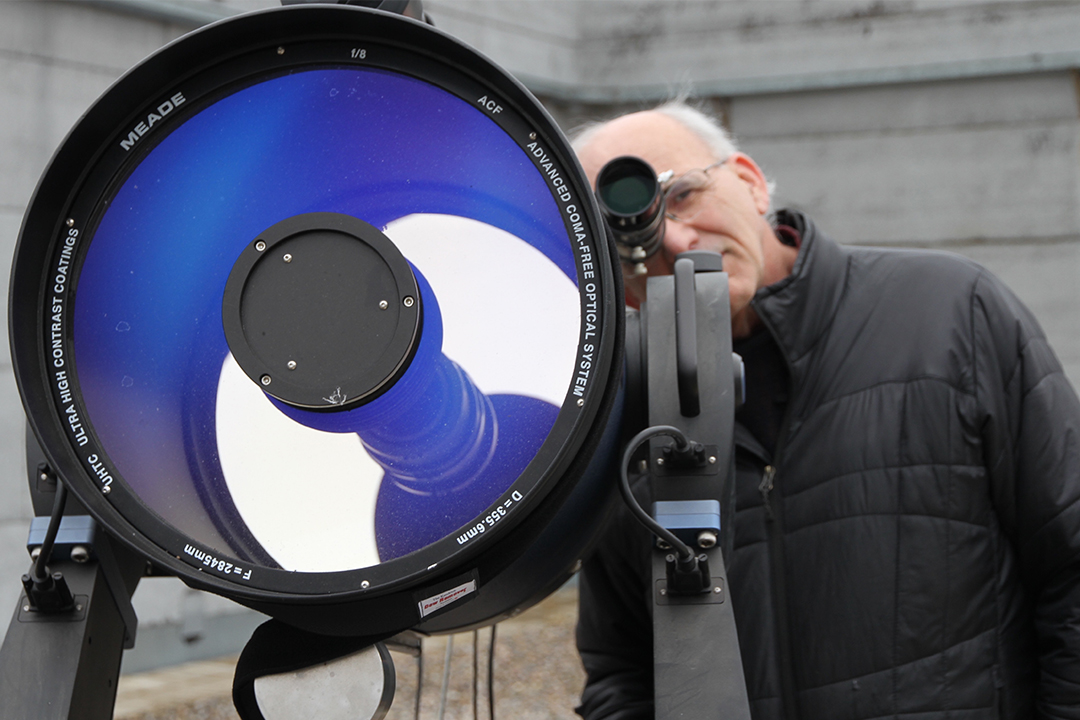
Shadick’s research is out of this world
It is one of the most fascinating and compelling questions of our time, debated by scientists and theologians alike: Are we alone in the universe?
By James ShewagaResearchers at the University of Saskatchewan (U of S) are part of the monumental search for answers.
“I believe that life could exist (elsewhere in the universe), but I am not absolutely convinced that life has to exist,” said U of S astronomy lecturer Stan Shadick. “Just because it is possible, does not necessarily mean that it does exist, in my opinion. I would like to see the evidence.”
Shadick and his astronomy students in the Department of Physics are part of an international effort to try to find that evidence. And one of the first steps to finding life elsewhere is to find a planet in another solar system—known as exoplanets—suitable to support life. The first published discovery of a confirmed exoplanet was made by a Canadian team of astronomers in 1988. Since then, a total of 3,537 have been documented by astronomers around the world, including at the U of S.
“We have only been able to study exoplanets in the last 10 or 15 years, so it is still a fairly hot topic and a fairly active topic in astronomy today,” said Shadick, who was listed as a co-author of a paper published in July by the Royal Astronomical Society after he helped confirm a Russian research team’s discovery of a new exoplanet. “What I find most valuable for us is this is research that we can do with our telescopes here at the University of Saskatchewan.”
The U of S physics department employs five telescopes ranging in diameter from 10 to 14 inches, with a 24-inch telescope—the largest in the province—to be installed next spring after being donated by the Tarasoff family. Through their observations, Shadick and his students have monitored 386 transits of exoplanets as they pass directly in front of other stars. The U of S research team is currently the leading contributor to the international Exoplanet Transit Database.
However, finding exoplanets is just the first step in the search for extraterrestrial life. Shadick said most experts theorize that exoplanets need to be relatively Earth-like in size and must orbit a star similar to our sun and at the correct distance—known as the habitable zone—to provide the correct temperature to allow liquid water to exist on the surface, one of the prerequisites for life on our planet. In addition, researchers believe exoplanets must have a moon of the right mass and proximity to create the tidal forces necessary for life to evolve.
“I think it’s a standard theory in biology that life began in tidal pools, so if that is indeed the mechanism for starting life, then to have life on other planets it would need a moon to create tides,” said Shadick. “What I can say is the Earth is very special in many regards. We have the right mass of planet, with the right chemistry, with the right kind of star, at the right distance and the right size of moon. So there are lots of special things about our planet that allows for life to exist.”
Like the majority of exoplanet discoveries, U of S researchers don’t directly view exoplanets, but measure small changes in a star’s light as a planet passes directly in front of—or transits—the star it orbits.
Discovering an exomoon is a much more complicated process, involving calculating the small variations in the speed that a planet orbits a star resulting from the gravitational effect of a moon that causes a planet to speed up or slow down.
“If you were to look at the earth-moon system from space, you would see the earth actually wobbles every month because of the gravity of the moon,” said Shadick. “So the work we are doing here could be used for the eventual discovery of an exomoon. There really is no confirmed verifiable discovery of an exomoon to date, so that would be exciting.”
However, that discovery would still be light years away, so to speak, from actually proving that life exists elsewhere in the universe. Theories such as the famous Drake equation and a more recent recalculation by researchers at the University of Washington estimate that the number of extraterrestrial civilizations in the Milky Way galaxy alone could be in the thousands. But making contact, given the vast expanse of space, is another question altogether.
“Our Milky Way galaxy has hundreds of billions of stars in it and there are billions of other galaxies, but they are extremely remote,” said Shadick. “Even within our own galaxy, the closest planetary system with life, if life does exist elsewhere, is probably fifty or a hundred light years away. And we are not seeing tourists from other solar systems, so they must be very, very, very far away, if they even exist at all.”

